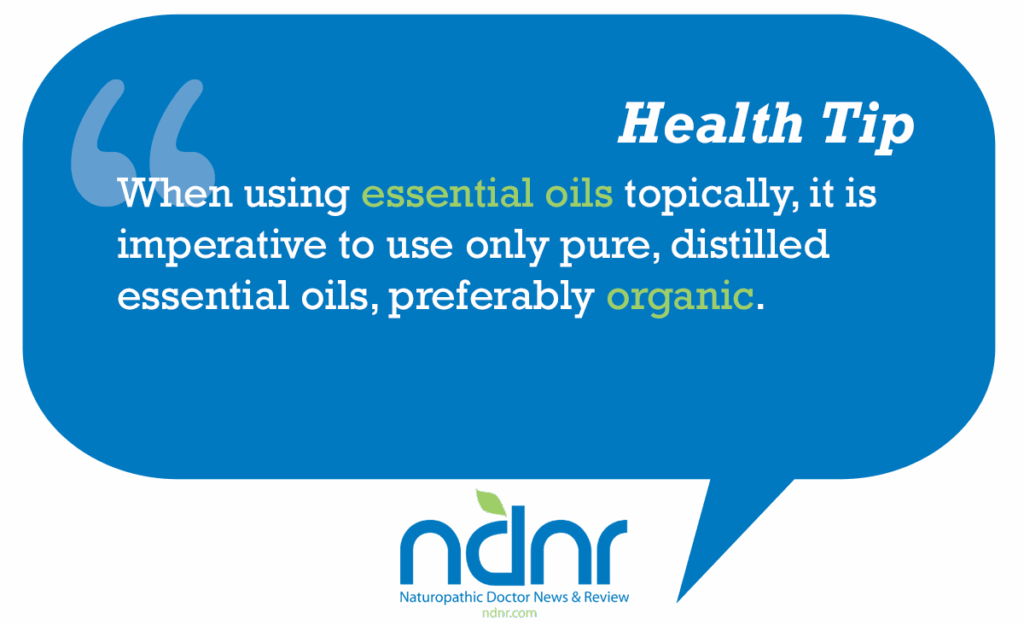An “Essential” for Healing Skin Conditions
Robin DiPasquale, ND, RH(AHG)
The skin is the largest organ of elimination of the body, one way for the entire body to clear the burdens of toxicity that have accumulated day to day. When considering botanical medicine for conditions of the skin, working from the inside out using alteratives, hepatics, diuretics and diaphoretics is important for decreasing the body burden and opening the emunctories. This will alleviate the need to eliminate so heavily through the skin. One step deeper is the use of biotherapeutic drainage and gemmotherapy to enhance elimination on an inter- and intra-cellular level. On a more topical note, many skin care products on the market are currently being produced using an array of herbs and herbal extracts. A closer look reveals that many of these products contain essential oils and hydrosols of the plants. These concentrated distilled volatile compounds, the essential oils and their water-based hydrosols, provide medicinal actions that can effectively be used to treat a diversity of skin conditions.
Topical Essential Oils
When using essential oils topically, it is imperative to use only pure, distilled essential oils, preferably organic, remembering that whatever is put on the skin is then absorbed through the skin. Unfortunately, the cost of high-quality, pure essential oils may deter some people from purchasing and using them. It is, however, a worthy investment, for when synthetic perfume oils are absorbed into the body there is an increase in the body burden of toxicity, which of course then needs to be eliminated. The same is true for the inhalation of these various aromatic substances. Inhalation of both the pure essential oils and the synthetically produced perfumes works through direct effect on the brain chemistry via the olfactory nerve; through this route, the synthetic perfumes bring toxic burden directly into the CNS.
There are many essential oils that can be used topically to treat skin conditions. This article will focus on the essential oil (EO) of one plant that is becoming more understood and utilized for its medicinal and healing qualities related to a variety of skin conditions. This plant is known by a number of names, including Everlasting, Immortelle, the Curry Plant, and its binomial name, Helichrysum italicum.
About Helichrysum italicum
There are about 600 species of Helichrysum worldwide; however, this article is primarily from the literature on H. italicum. The EO of the many species potentially can be used interchangeably. This plant genus prefers to grow in warm, sunny, dry climates, often high on hillsides and southern-exposure mountain slopes, which can enhance the volatile properties. In Greek mythology the sun was personified as the god Helios, and Khrysos was the spirit of gold, this beautiful aromatic being called so for its golden crown of flowers used to distill its precious oil.
The primary actions of H. italicum are anti-inflammatory and regenerating, primarily a result of the 10% diketones. It is antiseptic, disinfecting wounds without being painful. The essential oil can be applied directly to a wound, undiluted. It will calm any inflammation and accelerate growth of new tissue. As the wound heals, Helichrysum will diminish scar formation, promoting healthy functional tissue to regenerate. Helichrysum EO can also be used to repair and diminish old scars. This regeneration action is due to its hydrophilic action, allowing penetration of the tissue. It can relax the pain, the sesquiterpene hydrocarbons being anti-inflammatory, analgesic and calming, useful in rheumatic conditions where it can be applied topically undiluted or diluted into a carrier oil. The esters bring antispasmodic effects. Helichrysum is antibacterial, antiviral and antifungal.
Rose hip seed oil, a carrier oil high in linoleic omega-6 FAs and linolenic omega-3 FAs, is itself a skin aid, used for burns, diminishing scars, eczema and protecting skin from aging effects. One company makes a product that combines rose hip seed oil and Helichrysum EO. Hazelnut oil is often preferred as a carrier oil, especially when preventing or treating scar tissue, because of its antisclerotic activity. This antisclerotic activity is also seen in the internal use of the Hazel tree, Corylus avellana, in the gemmotherapy extract, the extract of the buds just as they open.
On the emotional level, Helichrysum italicum is calming, nourishing and harmonizing. It is used to calm emotional pain, heal emotional bruising and untangle emotional knots that prevent healing. It encourages inner strength and awareness related to these emotional wounds, making it easier for someone to be aware of them, accept them and find forgiveness, releasing resentment, anger, bitterness and stubbornness. This facilitates letting go and freeing energy in order to move on and engage more fully in life. The ability to have compassion for self and others is restored and renewed. Everlasting has an affinity for the solar plexus, and is related to the wood element in Five Element TCM. It is about relinquishing the need to be in control, realizing that each individual person’s flow of qi is linked to the bigger flow of qi within the universe.
Applications for Helichrysum
There are many applications of Helichrysum italicum, and other essential oils, for treatment of skin conditions. Use your clinical knowledge and judgment, or consult the aromatherapy content in the reference list. See the accompanying text, which includes a list of some dermatological conditions where H. italicum can be applied, along with suggested essential oil combinations.
Topical Mixture for Scar Healing, Old and New
1% Helichrysum EO
15% flax seed oil
84% base oil, hazelnut oil and/or rose hip seed oil
For preventing the formation of new scars, begin to apply one week after surgery. Continue to apply 2-3 times a day for 3-6 months to the scar. For old scars, apply 2-3 times a day for 3-6 months. Mixing Helichrysum in a base of comfrey cream (Symphytum officinale) can accelerate the healing due to the vulnerary and regenerative actions of the allantoin in the comfrey.
Dermatological Conditions for H. italicum
Scars and Cheloid Formation
Apply daily for an extended time, 3-6 months
- italicum EO, rose hip seed oil and/or hazelnut oil
Salvia officinalis EO (sage) added for slow-healing wounds or old scars
Stretch Marks
- italicum EO can be used in combination with the below oils:
- For prevention: use mandarin EO or Neroli and cypress EO with rose hip seed and hazelnut oils massaged in daily during pregnancy.
- For healing: Rosemarinus officinalis EO (rosemary, verbenone type) and Salvia officinalis EO with same carrier oils.
Wounds and Cuts
For pain relief and to accelerate healing, apply undiluted directly. H. italicum EO can be combined with Lavandula angustifolia EO (lavender).
Hematomas
- italicum EO applied undiluted topically and immediately to an area impacted can prevent the formation of a hematoma due to its anticoagulant action. Applied topically after the bruising will speed up healing.
Eczema and Psoriasis
- italicum works on calming the nervous system, which contributes to the healing of eczema and psoriasis. Use Helichrysum EO along with the following:
- Dry Eczema: Lavandula angustifolia EO, Cymbopogon martini EO (palmarosa), Calophyllum inophyllum oil (ballnut) and rose hip seed oil. The gemmotherapy extract of Cedrus Libani (dedar of Lebanon) is also indicated for dry eczema.
- Wet Eczema: Thymus vulgaris EO (thyme, thujanol type), Eucalyptus citriodora EO (lemon eucalyptus), Calophyllum oil and rose hip seed oil. The gemmotherapy extract of Ulmus campestre (elm) is also indicated for wet eczema.
Muscle/Tendon/Ligament Inflammation, Sprains, Strains
For injuries after a strong work out or asana yoga practice, apply topically H. italicum EO, Achillea millefolium EO (yarrow) and Eucalyptus citriodora EO in a base of comfrey cream or the carrier oils of rose hip seed and Hazelnut.
Herpes Simplex
Apply H. italicum topically undiluted hourly during prodrome. Use it in the carrier oil of Hazelnut multiple times a day after a lesion outbreak to retain moisture during the healing time.
- italicum EO is antiviral and can be used with any of the following essential oils: Lavandula angustifolia, Geranium, Melissa officinalis (lemon balm), Eucalyptus radiata and Eucalyptus citriodora, and Melaleuca leucadendron (tea tree).
Herpes Zoster/Shingles
Combine the following into a blend: H. italicum EO, Ravensara EO and Calophyllum inophyllum, which is a hybrid between an essential oil and a fatty oil, called an aromatic fatty oil acquired through pressing the fruit of this tree. It has immune enhancing qualities, especially stimulating phagocytosis.
Burns
Apply Lavandula angustifolia EO undiluted topically, along with ice cold application. H. italicum EO and Matricaria recutita EO (German chamomile) can be used topically in addition, or over the next few days undiluted.
Detox
Detoxification through the skin can be enhanced through dry skin brushing daily. Apply topically the EOs of H. italicum, L. angustifolia and Eucalyptus citriodora before brushing. Place a few drops of the oils on the hand, gently apply to the area of the body to be stimulated, then brush. Taking a hot shower after brushing enhances the detoxification.
Tinea of Most Types
The following essential oils can be combined with the antifungal properties of H. italicum: Lavandula angustifolia, Melaleuca leucadendron and Thuja plicata (western red cedar). For most tineas, mix 50% EO and 50% carrier oil, the carrier oil assisting through smothering the area and creating an anaerobic environment. This smothering is especially important for Tinea unguium, which can take weeks to months to resolve.
Acne
The EO of Mentha piperita (peppermint) taken internally will assist in liver detox; 1 drop in water or on a tablet or capsule daily. Besides liver and kidney drainage, the following EO can be used topically, undiluted or mixed with rose hip seed oil: Thymus vulgaris (thyme linalol), Lavandula angustifolia, Melaleuca quinquenervia viridiflora (Niaouli), Melaleuca leucadendron and Rosmarinus officinalis.
Cellulite
Preventing or treating cellulite requires an increase in circulation, as well as regenerative effects on the connective tissue. H. italicum EO can be combined with any of the following EOs that are focused on increasing circulation, while Helichrysum works with the regeneration. Mix 2ml EO combination to 100ml Hazelnut oil and apply topically: Eucalyptus citriodora, Citrus limonum (lemon), Cedrus atlanticus (Atlas cedar), Salvia officinalis, Rosmarinus officinalis, and Melaleuca quinquenervia viridiflora.
 Robin DiPasquale, ND, RH(AHG) earned her degree in naturopathic medicine from Bastyr University in 1995 where, following graduation, she became a member of the didactic and clinical faculty. For the past eight years, she served at Bastyr as department chair of botanical medicine, teaching and administering to both the naturopathic medicine program and the bachelor’s of science in herbal sciences program. Dr. DiPasquale is a clinical associate professor in the department of biobehavioral nursing and health systems at the University of Washington in the CAM certificate program. She loves plants, is published nationally and internationally, and teaches throughout the U.S. and in Italy about plant medicine. She is an anusara influenced yoga teacher, teaching the flow of yoga from the heart. She currently has a general naturopathic medicine practice in Madison, Wis., and is working with the University of Wisconsin Integrative Medicine Clinic as an ND consultant.
Robin DiPasquale, ND, RH(AHG) earned her degree in naturopathic medicine from Bastyr University in 1995 where, following graduation, she became a member of the didactic and clinical faculty. For the past eight years, she served at Bastyr as department chair of botanical medicine, teaching and administering to both the naturopathic medicine program and the bachelor’s of science in herbal sciences program. Dr. DiPasquale is a clinical associate professor in the department of biobehavioral nursing and health systems at the University of Washington in the CAM certificate program. She loves plants, is published nationally and internationally, and teaches throughout the U.S. and in Italy about plant medicine. She is an anusara influenced yoga teacher, teaching the flow of yoga from the heart. She currently has a general naturopathic medicine practice in Madison, Wis., and is working with the University of Wisconsin Integrative Medicine Clinic as an ND consultant.
References
Angioni A et al: Chemical composition, plant genetic differences, and antifungal activity of the essential oil of Helichrysum italicum G. Don ssp microphyllum (willd) Nyum, J Agrc Food Chem Feb 12;51(4):1030-4, 2003.
Appendino G et al: The phloroglucinol alpha-pyrone Arzanol, J Nat Prod Apr;70(4):608-12, 2007.
Buckle J: Clinical Aromatherapy in Nursing. London, 1997, Arnold/Hodder Headline Group.
Chinon B et al: Chemical and biological studies of two Helichrysum species of Greek origin, Planta Med Aug:62(4):377-9, 1996.
Debacq-Chainiaux F et al: Identification of potential anti-photo aging algal compounds using an in-vitro model of photo aging, J Pharm Pharmacol Dec;58(12):1577-83, 2006.
Mojay G: Aromatherapy for Healing the Spirit. Rochester, 1997, Healing Arts Press.
Nostro A et al: Modifications of hydrophobicity in vitro adherence and cellular aggregation of streptococcus mutans by Helichrysum italicum extract, Lett Appl Microbiol 38(5):423-7, 2004.
Nostro A et al: Helichrysum italicum extract interferes with the production of enterotoxins by Staphylococcus aureus, Lett Appl Microbiol 35(3):181-4, 2002.
Rosa A et al: Inhibition of non-enzymatic liquid peroxidation, Chem Boil Interact Jan 30;165(2):117-26, 2007.
Sala A et al: Antiinflammatory and antioxidant properties of Helichrysum italicum, J Pharm Pharacol 54:365071, 2002.
Schnaubelt K: Medical Aromatherapy, Healing with Essential Oils. Berkeley, 1999, Frog Ltd.
Schnaubelt K: Advanced Aromtherapy, The Science of Essential Oil Therapy. Rochester, 1998, Healing Arts Press.
Worwood V: The Fragrant Heavens, The Spiritual Dimension of Fragrance and Aromatherapy. Novato, 1999, New World Library.








